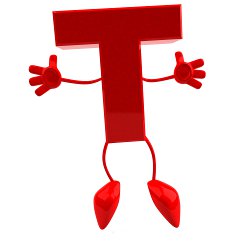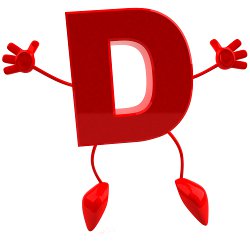T and D Sounds
t:(top, it, later)
d:(do, had, made)
English Pronunciation, Lesson 24
The T and D sounds are often studied as a pair because both sounds are stop consonants. They are produced in similar ways, but the T sound is voiceless and the D sound is voiced. What does all of this mean? Read on to find out.
Click Here for Step-by-Step Rules, Stories and Exercises to Practice All English Tenses
How to pronounce the T and D sounds
The voiceless (unvoiced) T
sound
(IPA
symbol: t(It is important to note that there are a few different ways to make the T sound. In this lesson, we study the true T sound. This is the most common way to make the T sound. If you want to learn the other ways to make the T sound, the video on this page will tell you more.)

The voiced D sound (IPA symbol: d

Voiced and voiceless sounds
In the English language, we use many voiced sounds. That means that the vocal cords vibrate when you say that sound. The D sound is a voiced sound because the vocal cords vibrate when you make the sound.The T sound is a voiceless or unvoiced sound because the vocal cords do not vibrate when you make the sound. Instead, we use a puff of air to make the sound.
Stop consonants
The T and D sounds should be studied together because they are both stop consonants made in the same part of the mouth. Stop consonants are made when the flow of air through your mouth is stopped by either your tongue or lips. This causes a build-up of air. When the air is released, it makes a small, explosive sound.To make the T and D sounds, your tongue stops the flow of air at the front of your mouth. In both of these sounds, the tip of your tongue presses against the back of your top teeth. The sides of your tongue will also press against the upper side teeth to stop the flow of air. There is more air released for the T sound, and less air released for the D sound.
Other stop consonants include
- P and B Sounds (Lesson
18)
- K Sound (kid,
lock)
- Hard G Sound (bug, get)
The T and D sounds are very similar. It is easiest to learn the differences between these two sounds by watching and hearing someone say them. Watch this cool video from Rachel's English to hear and see the differences between the T and D sounds. (Notice that Rachel shows a few different ways to make the T sound.)
Doesn't Rachel do an amazing job showing the differences between these two sounds? Now it is time for you to practice saying each sound.
Practice the voiced D sound
Practice the voiced D sound by saying these words. Hold a piece of paper or your hand in front of your mouth to make sure you are voicing the consonant and not using a puff of air. The paper should not move much when you make a voiced sound.
- dad
- do
- did
- dog
- mad
- sad
- bad
- done
- loud
- and
Now practice the voiceless T sound
Use a piece of paper to practice the voiceless T sound. When you say this sound, you should release a puff of air from your mouth that moves the paper. Your vocal cords should not vibrate.
- to
- top
- it
- get
- hot
- pot
- to
- butter
- later
- what
Remember to voice the D sound and use a puff of air for the T sound!
| D | T |
| do |
to |
| did | tot |
| bad | bat |
| and | ant |
| sad | sat |
Challenge words!
These words have both sounds! Practice them slowly.
The T sounds are in blue. The D sounds are in green.
- today
- Tuesday
- Saturday
- dot
- tried
- diet
- date
- wanted
Now say these sentences out loud.
The T sounds are in blue. The D sounds are in green:
1) Get it down.
2) It was hot today.
3) What did she do at the top?
4) Did it stop at the bottom?
5) Dan and Tina had a date on Tuesday.
Remember to practice these two sounds together, so you can learn their differences!
Let's move on...
List of Lessons
Lesson 01: International
Phonetic Alphabet (IPA)
Lesson 02: Word
Stress and Syllables
Lesson 03: Long E
sound (meet,
see)
Lesson 04: Short I
Sound (sit,
hit)
Lesson 05: UH Sound
(put, foot)
Lesson 06:
OO Sound (moon,
blue)
Lesson 07: Short E
sound (pen, bed)
Lesson 08: Schwa
Sound (the, about)
Lesson 09: UR Sound (turn, learn)
Lesson 10: OH Sound (four, store)
Lesson 11: Short A
Sound (cat, fat)
Lesson 12: UH Sound (but, luck)
Lesson 13: Soft A
Sound (arm, father)
Lesson 14: Long O
Sound (boat,
know)
Lesson 15: Long A
Sound (say, pain, make)
Lesson 16: Short O
Sound (not, off, socks)
Lesson 17: Diphthong
(a combination of two vowel sounds)
Lesson 18: P Sound
(cup, punch, pull) and B sound (cub, bunch, bull)
Lesson 19: The Nasal
Sounds (M, N, NG)
Lesson 20: F Sound (four, lift, graph, tough) and V Sound (love, knives, grave, vine)
Lesson 21: W Sound (wow, quit, where)
Lesson 22: R Sound (red, sorry, write)
Lesson 23: H Sound (he, behind, who)
Lesson 24: T Sound (top, it, later) and D Sound (do, had, made)
Lesson 25: S Sound (sit, box, cats) and Z Sound (zip, buzz, boys)
Lesson 26: K Sound (kid, talk, black) and G Sound (go, big, dog)
Lesson 27: L Sound:
Light L & Dark L (tall,
like, English)
Lesson 28: Y
Consonant Sound (yes,
you, beyond)
Lesson 29: CH Sound (China, century, watch) and J Sound (Germany, educate , judge)
Lesson 30: TH
Consonant Sounds – voiced TH sound (the,
father, them) and voiceless
(unvoiced) TH sound (think,
birthday, south)
Lesson 31: SH
(shop, chef, special) and ZH (usual, massage, Asia)
Lesson 32: T and TT Sounds (true T sound, D sound, stop sound, silent T)
Get Updates, Special Offers, and English Resources
Download your FREE GIFT (the first two chapters of
English Short Stories Book and Workbook)
as soon as you join!

By submitting your email, you consent to receiving updates and newsletters from us and to the sharing of your personal data with third parties for the purposes of sending you communications. We will not spam you. You can unsubscribe at any time. For more information, please see our privacy policy.





